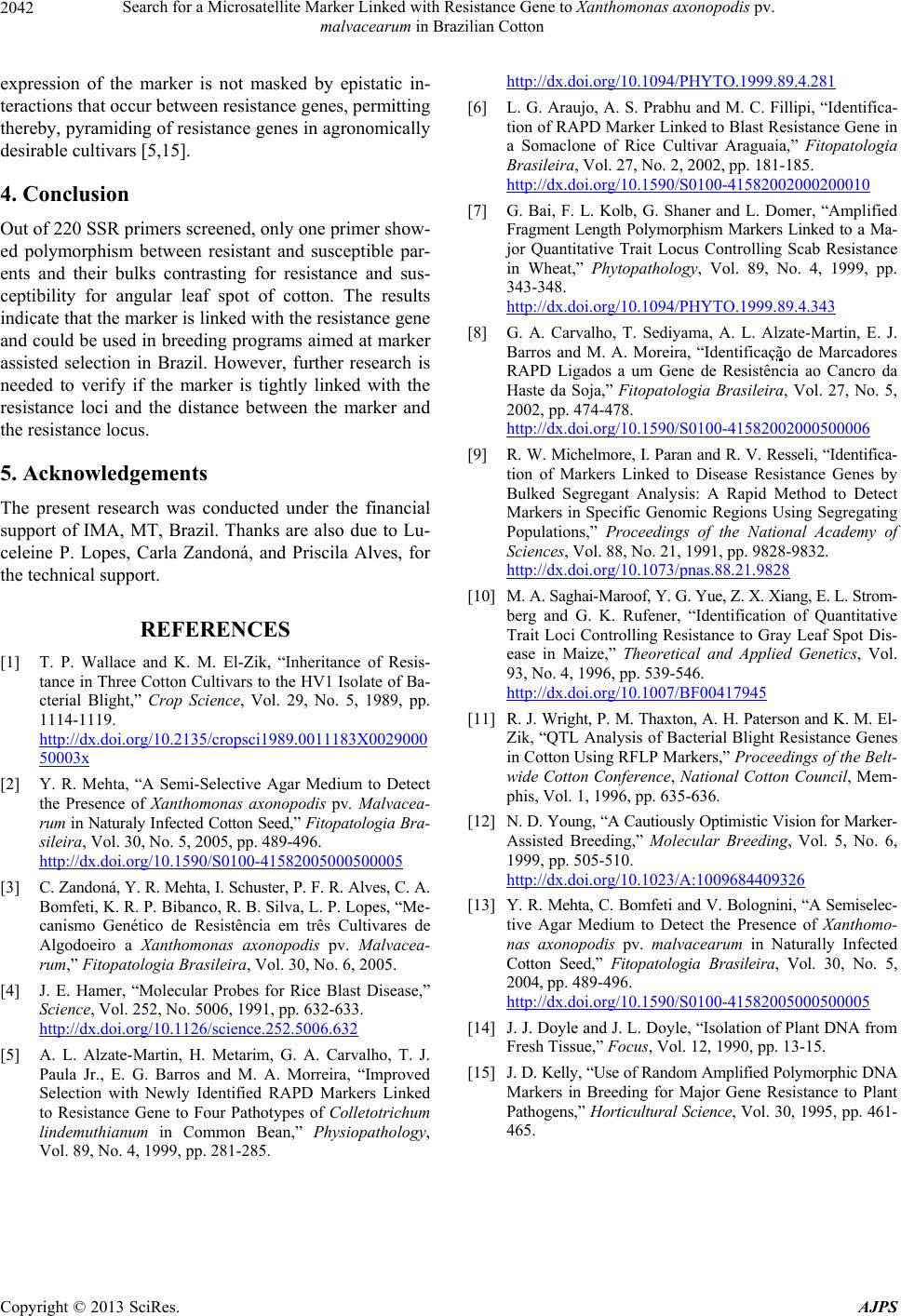
Search for a Microsatellite Marker Linked with Resistance Gene to Xanthomonas axonopodis pv.
malvacearum in Brazilian Cotton
2042
expression of the marker is not masked by epistatic in-
teractions that occur between resistance genes, permitting
thereby, pyramiding of resistance genes in agronomically
desirable cultivars [5,15].
4. Conclusion
Out of 220 SSR primers screened, only one primer show-
ed polymorphism between resistant and susceptible par-
ents and their bulks contrasting for resistance and sus-
ceptibility for angular leaf spot of cotton. The results
indicate that the marker is linked with the resistance gene
and could be used in breeding programs aimed at marker
assisted selection in Brazil. However, further research is
needed to verify if the marker is tightly linked with the
resistance loci and the distance between the marker and
the resistance locus.
5. Acknowledgements
The present research was conducted under the financial
support of IMA, MT, Brazil. Thanks are also due to Lu-
celeine P. Lopes, Carla Zandoná, and Priscila Alves, for
the technical support.
REFERENCES
[1] T. P. Wallace and K. M. El-Zik, “Inheritance of Resis-
tance in Three Cotton Cultivars to the HV1 Isolate of Ba-
cterial Blight,” Crop Science, Vol. 29, No. 5, 1989, pp.
1114-1119.
http://dx.doi.org/10.2135/cropsci1989.0011183X0029000
50003x
[2] Y. R. Mehta, “A Semi-Selective Agar Medium to Detect
the Presence of Xanthomonas axonopodis pv. Malvacea-
rum in Naturaly Infected Cotton Seed,” Fitopatologia Bra-
sileira, Vol. 30, No. 5, 2005, pp. 489-496.
http://dx.doi.org/10.1590/S0100-41582005000500005
[3] C. Zandoná, Y. R. Mehta, I. Schuster, P. F. R. Alves, C. A.
Bomfeti, K. R. P. Bibanco, R. B. Silva, L. P. Lopes, “Me-
canismo Genético de Resistência em três Cultivares de
Algodoeiro a Xanthomonas axonopodis pv. Malvacea-
rum,” Fitopatologia Brasileira, Vol. 30, No. 6, 2005.
[4] J. E. Hamer, “Molecular Probes for Rice Blast Disease,”
Science, Vol. 252, No. 5006, 1991, pp. 632-633.
http://dx.doi.org/10.1126/science.252.5006.632
[5] A. L. Alzate-Martin, H. Metarim, G. A. Carvalho, T. J.
Paula Jr., E. G. Barros and M. A. Morreira, “Improved
Selection with Newly Identified RAPD Markers Linked
to Resistance Gene to Four Pathotypes of Colletotrichum
lindemuthianum in Common Bean,” Physiopathology,
Vol. 89, No. 4, 1999, pp. 281-285.
http://dx.doi.org/10.1094/PHYTO.1999.89.4.281
[6] L. G. Araujo, A. S. Prabhu and M. C. Fillipi, “Identifica-
tion of RAPD Marker Linked to Blast Resistance Gene in
a Somaclone of Rice Cultivar Araguaia,” Fitopatologia
Brasileira, Vol. 27, No. 2, 2002, pp. 181-185.
http://dx.doi.org/10.1590/S0100-41582002000200010
[7] G. Bai, F. L. Kolb, G. Shaner and L. Domer, “Amplified
Fragment Length Polymorphism Markers Linked to a Ma-
jor Quantitative Trait Locus Controlling Scab Resistance
in Wheat,” Phytopathology, Vol. 89, No. 4, 1999, pp.
343-348.
http://dx.doi.org/10.1094/PHYTO.1999.89.4.343
[8] G. A. Carvalho, T. Sediyama, A. L. Alzate-Martin, E. J.
Barros and M. A. Moreira, “Identificação de Marcadores
RAPD Ligados a um Gene de Resistência ao Cancro da
Haste da Soja,” Fitopatologia Brasileira, Vol. 27, No. 5,
2002, pp. 474-478.
http://dx.doi.org/10.1590/S0100-41582002000500006
[9] R. W. Michelmore, I. Paran and R. V. Resseli, “Identifica-
tion of Markers Linked to Disease Resistance Genes by
Bulked Segregant Analysis: A Rapid Method to Detect
Markers in Specific Genomic Regions Using Segregating
Populations,” Proceedings of the National Academy of
Sciences, Vol. 88, No. 21, 1991, pp. 9828-9832.
http://dx.doi.org/10.1073/pnas.88.21.9828
[10] M. A. Saghai-Maroof, Y. G. Yue, Z. X. Xiang, E. L. Strom-
berg and G. K. Rufener, “Identification of Quantitative
Trait Loci Controlling Resistance to Gray Leaf Spot Dis-
ease in Maize,” Theoretical and Applied Genetics, Vol.
93, No. 4, 1996, pp. 539-546.
http://dx.doi.org/10.1007/BF00417945
[11] R. J. Wright, P. M. Thaxton, A. H. Paterson and K. M. El-
Zik, “QTL Analysis of Bacterial Blight Resistance Genes
in Cotton Using RFLP Markers,” Proceedings of the Belt-
wide Cotton Conference, National Cotton Council, Mem-
phis, Vol. 1, 1996, pp. 635-636.
[12] N. D. Young, “A Cautiously Optimistic Vision for Marker-
Assisted Breeding,” Molecular Breeding, Vol. 5, No. 6,
1999, pp. 505-510.
http://dx.doi.org/10.1023/A:1009684409326
[13] Y. R. Mehta, C. Bomfeti and V. Bolognini, “A Semiselec-
tive Agar Medium to Detect the Presence of Xanthomo-
nas axonopodis pv. malvacearum in Naturally Infected
Cotton Seed,” Fitopatologia Brasileira, Vol. 30, No. 5,
2004, pp. 489-496.
http://dx.doi.org/10.1590/S0100-41582005000500005
[14] J. J. Doyle and J. L. Doyle, “Isolation of Plant DNA from
Fresh Tissue,” Focus, Vol. 12, 1990, pp. 13-15.
[15] J. D. Kelly, “Use of Random Amplified Polymorphic DNA
Markers in Breeding for Major Gene Resistance to Plant
Pathogens,” Horticultural Science, Vol. 30, 1995, pp. 461-
465.
Copyright © 2013 SciRes. AJPS